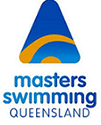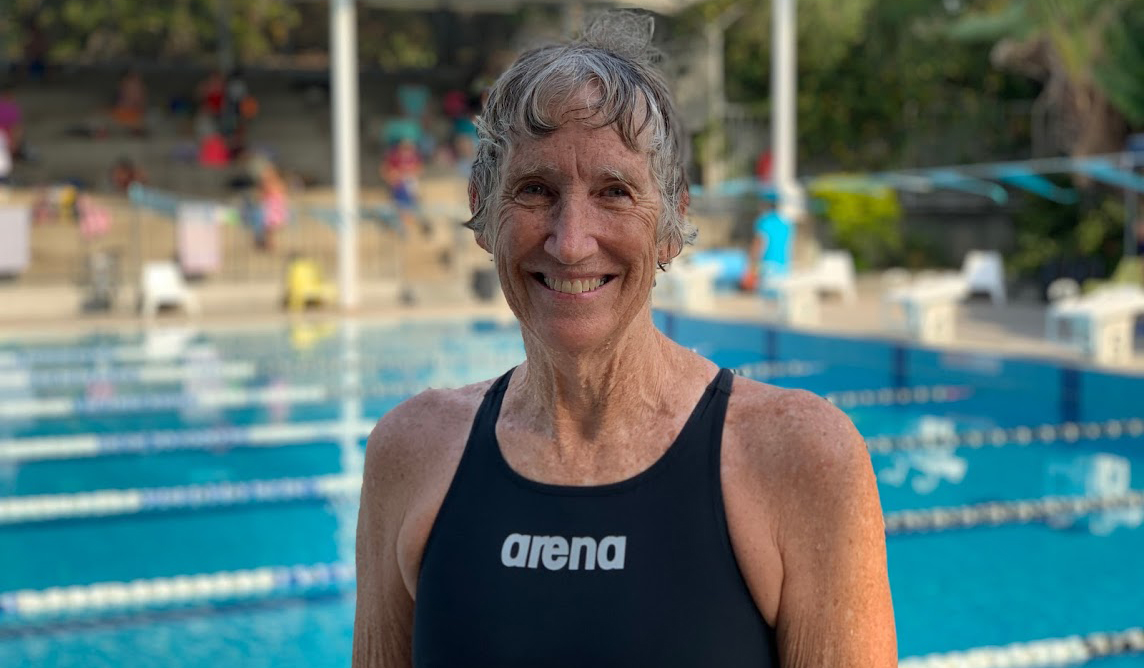
Tracy Clarkson – My Swimming Story
“Life is a journey, not a destination”, is a well known phrase. For me, swimming has been an important part of that journey, beginning with a short, four year swimming “career” in my youth, and more lately, the long, lingering Masters Swimming “career” that began in the late 1980s and continues to this day. This is my swimming story.
My relationship with water began as a small child, and continued through my life, shaping events that have created the journey that has led me to where I am today, with Masters Swimming Queensland, Australia and the US. They all include the three elements of fitness, fun and friendship, which are all important parts of my life.
From my very first swim, I have always felt at home in the water and drawn to it. For me, water is is a nice place to relax. It is a happy place to be. I am at home in the pool, in lakes, and in the surf. They each have their own enjoyment factor. The most dynamic is body surfing! The power of the waves pushing you toward the beach is a real rush! A couple of QBN team mates were witness to my longest ever body surf at Victoria Bay in South Africa. When I finally was able to catch the 1m+ fast moving wave, it carried me a very long distance. I seemed to never end! What a buzz! I re-live that surf experience in my head on occasion – a real highlight of my life! 10 members of our club (QBN) competed at the South African Masters Nationals in Durban in April, 2016. After the swimming, the safaris we went on and other travels in Africa left us with many great memories.
My childhood “swimming career” was fairly short-lived (ages 12 to 17), but hugely important, interrupted by many moves in my early years, and the lack of opportunities to keep swimming later on. However, Masters Swimming has allowed me to get back into it long term, get fit and challenge myself in many different ways in the water. These include some Open Water events in the surf and lakes, pool events in many competitions and programs such as the Endurance 1000 program and ePostal events, mainly USMS ones. It is great to be part of a great club with friendly people who are like-minded in their love of swimming.
The Early Years
My first experiences with swimming were in Hawaii, where my dad, a US Naval Officer, was stationed at Pearl Harbor in the early 50s. I felt right at home in the waters of Makalapa Pool and on occasional beach visits. In early swimming lessons I remember being stuck on the side of the pool impatiently waiting for my turn. I wanted to swim!
At aged 8, we moved from Hawaii to Peekskill, New York, where there was only a local swimming hole, a damned creek, which created an oval-shaped pond with a floating dock in the deep section. It had a sandy beach and a kiosk and we paid to get in. We spent hours there in the hot, humid summers. My passion then was horses and I had riding lessons and dreams of owning my own horse. (That never happened!)
After three years in New York, in 1961 we moved to New Jersey for a year when my father was Engineer Officer of the USS Kitty Hawk, a large aircraft carrier being built in Camden Shipyard, near Philadelphia. We lived on a lake in the community of Medford Lakes. We swam at the little public beaches on the lakes, packed a lunch and took canoe trips through the various lakes or cycled a few miles up to the local fire tower, which protected the pine barrens in New Jersey. We would climb up and have a chat with the ranger. Ah, the freedom we had! No PPDs, no helmets, home by dark! Each summer, there was a mile long swim (1650m) in the big lake. There were two girls, Gayle and Allison Bende, who would win and place each year. These excellent swimmers trained at Vesper Boat Club Swimming (VBC) Team in Philadelphia, a well-known club coached by Mary Freeman Kelly. That made an impression on me. Because of my enthusiasm for swimming, I decided to enter the swim (with no training) and I got a participation medal for completing it and was quite proud. My first ever medal.
Swim Team Years……
The Kitty Hawk’s new home base was Coronado, California, where we lived for the next two years. The Naval Amphibious Base had a swim team called the CNSA Red Sharks, coached by Mike Troy, a Navy Seal and Olympic gold medalist for the 200 fly and 4 x 200 free relay in Rome, 1960. (He was a coach and owned a swim school in Arizona when he passed away in 2018.) I finally joined a swimming club at age 12. I enjoyed the training and spent hours trying to learn a flip turn (we had to touch the wall with our fingers before the turn in those days, and, of course, no goggles). I competed in swim meets in the San Diego area in mainly sprints and relays. I managed to get a few bronze and silver medals. Our team did okay unless the Los Angeles swimmers showed up. They were really good! Near the end of my time there, I entered a 400 yard long course freestyle event at Camp Pendleton, a Marine base. One end of the pool was really deep because they did cockpit evacuation drills there, and it was so dark that it felt like you had stopped when swimming over it. At the end of that swim I was a record holder for our PSA (Pacific Southwest Association) region. I found out I was a middle distance swimmer, as I had never swum more than 100m in a race!
My father was transferred east again and we moved back to Medford Lakes, New Jersey for grade 9 and 10, and this time I wanted to compete more seriously. (Medford Lakes was handy for my swimming and my mother’s golf!) I wanted to try out for Vesper Boat Club Swimming team, coached by Mary Freeman Kelly (“A” team women) and George Breen (men and “B” team), (George passed away just a short time ago from cancer). Mary saw me swim, looked at my times and my advanced age and must have decided there was some potential. I started training with George and the “B” team. However, I was chosen to compete in the 200yd and 500yd freestyle in the dual meets as part of the “A” team against clubs in the greater Philadelphia area in the winter season. The first few months were hard, as I knew no one, because I trained with and competed with different swimmers. (By the time I got back to Vesper, the Bende sisters were no longer swimming.)
Finally, I was asked to train with the “A” team. It was so embarrassing that first night, as I couldn’t complete the interval swims in enough time to get a rest before the next one. I did one long swim! That was not a good start! However, things improved with fitness! I swam three years with Vesper (VBC), including two summers of long course swimming. The summer after year 10, I qualified and competed at the US Nationals in the 1500m free, boarding with the coach after my father was transferred back to San Diego. After grade 11 in California, I flew back to Philadelphia from California for the summer, again boarding with Mary and John B Kelly (“Kell”) and their family. (It was exciting for me when Ann and Susie, their two eldest daughters, aged 10 and 11, went to Monaco for three weeks to stay with Aunt Grace and Uncle Rainier and their cousins, Caroline, Albert and Stephanie.) Mary and Kell always opened their home to swimmers in the summers if they had far to travel. Their five children became surrogate brother and sisters.
My swimming steadily improved, I picked up some local medals and I went to the US Nationals again, qualifying again for the 1500m free. I also swam on the VBC “D” team for the 4 x 200m relay. After a summer of very hard work in the pool, Vesper came within a few points of defeating Santa Clara Swim team that year (1966). Many of the Vesper swimmers were chosen for various US Swimming trips to other parts of the world as a result of their achievements. Five of Mary’s swimmers went to the Olympics during her coaching career. I was not in that league!
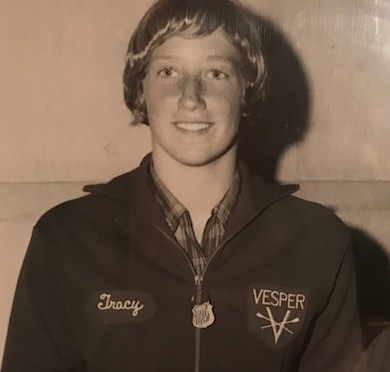
Those years with VBC had a huge impact on my life. Mary, my coach, was an amazing role model for all of us. Many (12) of her swimmers, after attending University, have become College or High School Swimming coaches themselves (After title IX opened up opportunities for women) or had varied and interesting careers. She realized that swimming was only one part of the picture. There was a reunion in 2018, and over 25 ex-VBC women swimmers, and Mary, attended 50 years later. Almost every person there called her the second most influential person in their lives growing up besides their parents! We all adore her, even now! (She retired from coaching in 1968 when she became a single parent of 6 children.) As I am self-coached, my training is based on our workouts from VBC and they have worked just fine! Mary did an interview with Swimming World in 2008 when she was inducted in to the Coaches Hall of Fame – it is on YouTube here.
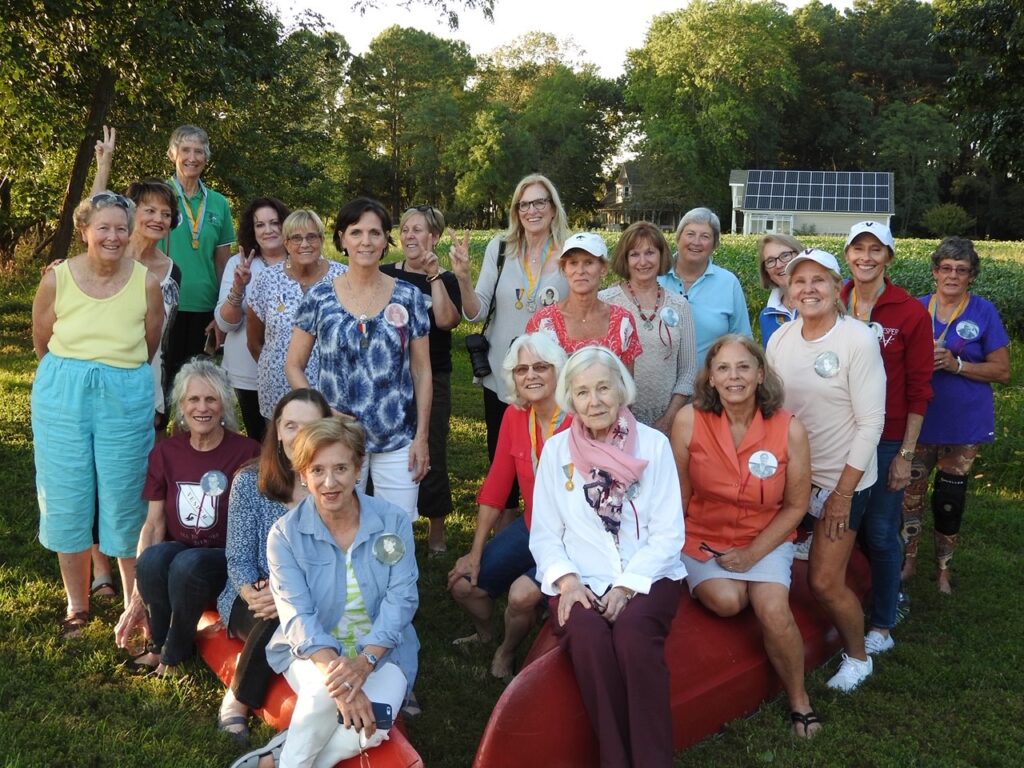
At the end of that summer, I flew back to California. I won my age group (15-16) in the 1966 La Jolla Rough Water Swim, and during the winter, competed in school competitions. (My mother, inspired by Mary, helped organize the first high school women’s competition in the San Diego area.) My first swimming career finished at the end of high school, when I went off to College (Uni). But, something happened near the end of my senior year (1967) of high school, which was to shape the course of my life.

Seventeen Magazine was a popular magazine in the US for teenagers, and in the early months of 1967 there was an advertisement promoting a competition to choose “Young Ambassadors” to cycle through Europe for six weeks in the summer sponsored by American Youth Hostels and Blue Bell Wrangler clothing. A nationwide competition, one had to write “under 100 words, why you wanted to be a Young Ambassador.” My 99 word entry was posted the last day possible. In due course, I received a letter telling me I was one of 300 semi-finalists that would be narrowed down to 90 winners. (There were 10 groups of 9 plus a leader, on different itineraries.) After writing an essay about my early life and education, and putting in country preferences, language ability and clothing sizes and listing referees in four areas, I had to wait to see what happened. Very nerve wracking! Little by little I would hear from a referee that they had been contacted. Finally, I got a telegram to say that I had won a place! That trip is a whole story in itself, and my new view of the world, and future possibilities, set me off to a life of travel experiences, and Masters Swimming fit in very well with that as time would tell…..
At university in my day, US College Sports Scholarships for girls were only handed out to US National finalists for only a couple of universities, as very few had a women’s swimming program. As a result, my swimming was put on hold, except for keeping fit and general recreation for many years. But swimming (and maybe Australia?) must have been on my mind, as in my first year at Stephens College in Columbia, Missouri, in Freshman English, we had to write a research paper on a topical subject. Mine was whether or not Dawn Fraser should have been banned from swimming after certain events after the Tokyo Olympics. I had to go to the University of Missouri library to access the NY Times on rolls of micro film to do that! Australia was on the radar of this ex-swimmer! (BTW- the conclusion was that she should not have been banned!)
Off to Australia……….and Masters Swimming
After two years in Missouri, I transferred to The University of California, Riverside, a suburb in Los Angeles. I was not happy there with the terrible smog and racial turmoil, so, after one term, I applied to study in Australia. I was accepted at the ANU in Canberra, in 1970, to continue my University Education, initially for a year, but I decided to stay. In that first year I participated in the Swim around Lake Burley Griffin event on Canberra Day and managed to be the first woman in. I was interviewed on TV too – straight out of the water! In 1972, I moved up to Brisbane, married, became a teacher and I worked full time as a teacher and teacher-librarian for many years. I also have two sons.
In 1988, my older brother mentioned that the FINA Masters World Swim was in Brisbane in October and I should enter. He had been swimming in Masters for a while in the US. I began training in May, 1988. My first carnival as a Brisbane Northside Masters (QBN) member was the Southside carnival at Chandler and I set myself goals for my swims at the Worlds: I wanted to break 6 min for the 400 free and get a top ten medal. I did a 5:59.85 for the 400free and got 9th in the 200 backstroke.
I swam for a while after the Worlds, but life was pretty full with career and small children and I suffered many viral illnesses and stopped. I went back briefly in 94-95 and got sick again. But in 1998 I started part time work, took training very steadily and have been at it ever since. Despite having to be very careful that I don’t overdue it with my training, I am fortunate to have been able to compete at all levels, from local carnivals to State and Nationals.

I went to my first overseas Worlds in Munich in 2000, and have been to every one since, combining my love of travel with swimming. After Munich, there was: Christchurch, NZ (2002), Riccione, Italy (2004), Stanford University in California (2006), Perth (2008), Gothenburg, Sweden (2010), Riccione, Italy (2012), Montreal, Canada (2014), they aligned with the Worlds in Kazan, Russia (2015), Budapest, Hungary (2017) and Gwangju, South Korea (2019). They are a great excuse for a trip. Usually there would be another trip somewhere after the competitions. Some nice trips have included swimming friends – a Russian River Cruise with Dawn Gledhill and last year, South Korea with Australian swimmers and a China trip after that with Therese Crollick. All of them were lots of fun. It is great to catch up with like-minded swimmers from around the world, all with their own inspiring Masters Swimming stories.



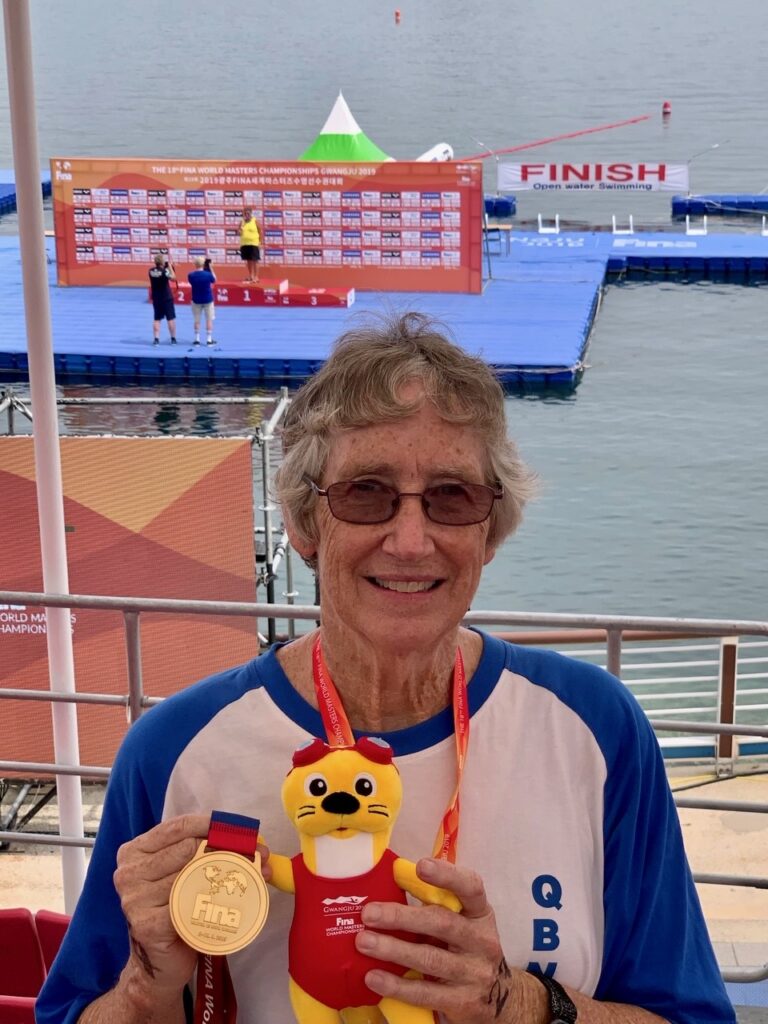
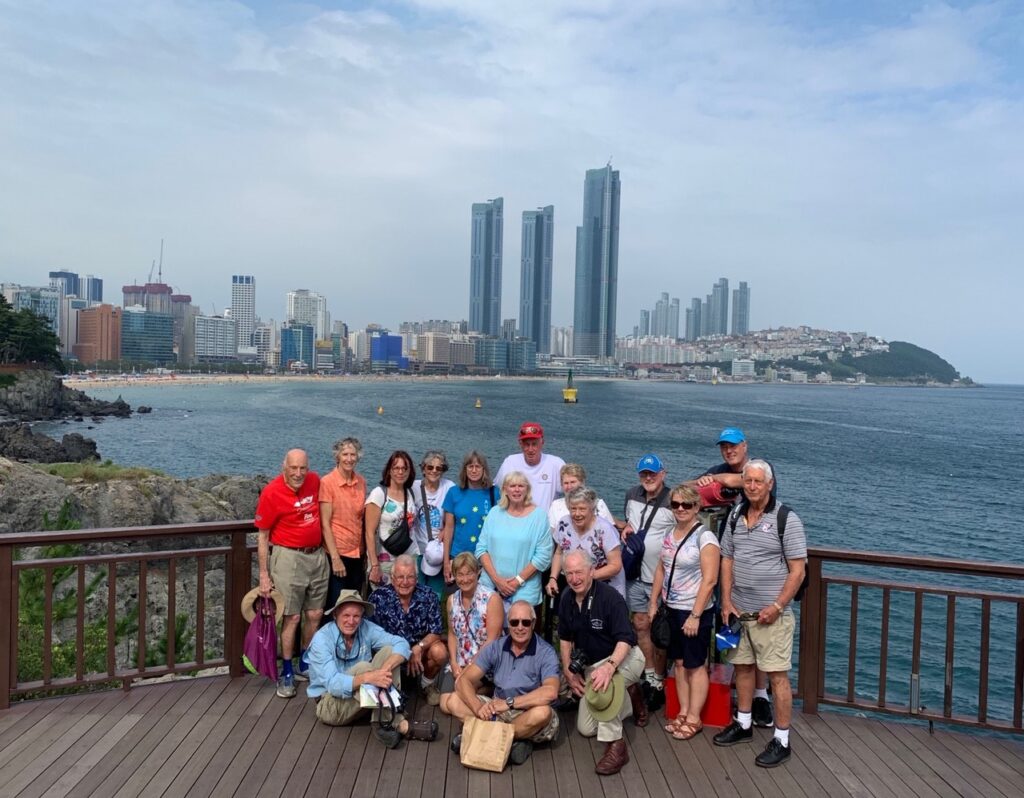
My goal for the Worlds has always been to try to get a top 10 (or now, top 6) medal. Anything else is a bonus. It is amazing to see older swimmers swimming incredible times. (Some over 50s Masters world records now were Open world records when I was swimming in the 60s.) I am very happy with the Top 10 medals I have been able to acquire, and more recently, some podium finishes and even some first places. I think the more conservative training routine I have used to keep me healthy has allowed me to keep my times more competitive as I get older. Also, I have completed the full aerobic program (Endurance 1000) each year since 1999. This is a good focus to keep training.
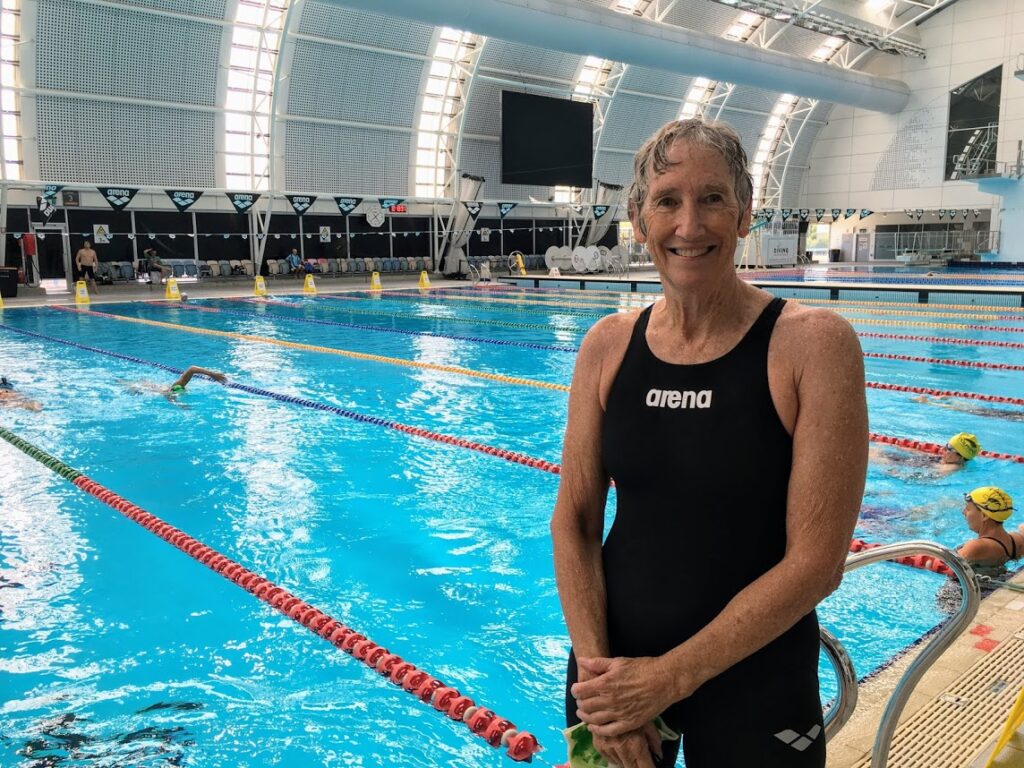
I am a member of a great club full of fantastic people who love swimming – Brisbane Northside Masters. During Covid isolation, many participated in Zoom sessions on Sundays, our usual meeting days, to keep in touch while the Valley Pool was closed. We were all very happy to get back to club swimming with our friends a couple of weeks ago, followed by breakfast at Café 63 nearby. Our new normal became swimming with no showers and “a quick change at the protected end of the pool unisex change room.” But now, we have change rooms and hot showers again!
As things open up in the post Covid19 era, training goes on, even if event participation may change. I guess we have to be prepared for changes happening at any time. This situation has just added to our story.
“Swimming will always be an important part of my life, whether it be just training, body surfing, competing or aerobics. Masters swimming has allowed many more opportunities for us swimmers as we get older and I, for one, will be the fitter and happier for it.“
I have however, learned a few things along the way, which probably helps me to keep doing this for the long run. They are:
- Social contacts are really important as we get older and I have met some wonderful people through swimming. I am still in contact with some VBC teammates of many years ago, and my QBN teammates and other Masters Swimmers I have met through competitions here and around the world are some of my closest friends.
- Use it or lose it is really important as we age and Masters Swimmers keep us moving. This moving and fitness allows us to face life’s challenges as we age, much more easily.
- That being said, I have learned that you also have to listen to your body and sometimes the recovery or just rest, is as important as the training.
- Also, I have learned not to worry about breaks from swimming for travel or health issues (including the present coronavirus). With perseverance and patience, you will get back to where you were before, or pretty close to it, if you are older.
- I have learned that you are (mostly!) never too old to learn something new and to try something different. Whether it is to make your swimming more enjoyable by making it more efficient, or learning tips and tricks to trim your times, watching others, checking out You Tube, or reading a swimming magazine can give you a different perspective on things.
A well known swimmer once said in an interview, after a disappointing result, “Swimming is what I do, not who I am.” But reflecting on that I think that swimming has to shape a little bit of who we are, as every swimming experience we have had in life, whether it be training or competition, good and bad, makes us part of who we are today. That is life.
“Masters Swimming is a unique community of like-minded people and I have felt so privileged to be a part of it. I also offer many thanks to those in this community who volunteer their time and effort in whatever capacity to make it the great group that it is.“
Sincere thanks to Tracy for sharing her swimming story. We would love to hear yours too! Please share your story via this email.



